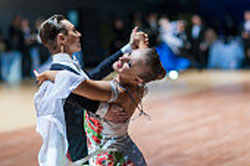
| HOME | MENU | DOCS | SEARCH |
see Recommended reading in dance. Symbols and abbreviations
One of the most beautiful and romantic dances, is included into the West European program of sports ballroom dances. Muses. size 3/4, rate of 56-60 t/min. (168-180 beats/min). In the XIX century I won popularity across all Europe. (See Waltz).
While the British prefer the romantic name of this dance is the Viennese waltz, also known as a quick waltz, that is fast. Despite its venerable age, the waltz retained its appeal and always has passionate fans. The name "Viennese waltz" — conditional. Waltz was born in Vienna during the Johann Strauss, and in Italy in the Renaissance, where it was called "volt". With the Peninsula volt migrated to France, and its success at the French court was stunning. All the courtiers enthusiastically danced in a circle.Soon, however, to the French throne Louis XIII, who was shocked by the style of the new dance and veto it.

Banned in France, Volta crosses, travels around Europe and, eventually, becomes a waltz. Dance gets rid of some of the movements and takes the form that is known today. Waltz returned to France only in the nineteenth century, and again had the same resounding success as in his time volt. The creators of the enchanting melodies of the waltz was the father and son of Strauss, lehár, Waldteuffel, and other great composers, including Schubert, Chopin, Berlioz, Tchaikovsky, Sibelius, Weber, Ravel.
Though the waltz made huge success and made the real furor at many yards of Europe, at the beginning of the XIX century the official relation to a waltz was very careful. At balls in Vienna no more than 10 minutes were allowed to dance a waltz - embraces of the gentleman and the lady in dance were considered as the unseemly. But no ban could stop spinning of a waltz on ball and concert halls of Europe. Since 1815, after a victory over Napoleon in Vienna at all balls selflessly danced a waltz - bewitching, magic, brilliant.
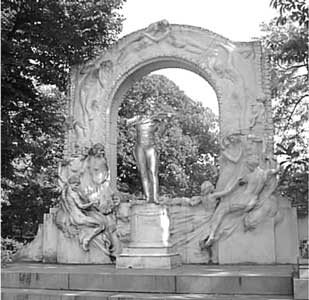
Vienna became history as the city where the waltz blossomed. The Vienna composers and conductors Lanner, Johann Strauss father and even more well-known Johann Strauss son who wrote masterpieces "On beautiful Blue Danube" and "Fairy tales of the Vienna wood", promoted formation of the Vienna waltz, and also that in the XIX century this dance eclipsed all others. Strauss's music improved and improved waltz choreography. Thanks to it dance began to be executed more gracefully, it is more beautiful and it is trembling.
In the gardens of Vienna there is a monument to Johann Strauss. Near it there is a small platform, on it Strauss with the chapel once acted. And today each summer evening from this platform melodies of waltzes under which sounds the public of the gardens dances are distributed. And only when there comes the turn of a waltz "On beautiful blue Danube" the conductor appeals not to dance: it is considered that it is necessary to listen to this melody which became the Austrian national shrine only reverentially...
Waltz, having become official ball dance, ideally I was in harmony and with fashion of that time: tight dresses in a waist with magnificent magnificent skirts emphasized beauty of movements of the lady.
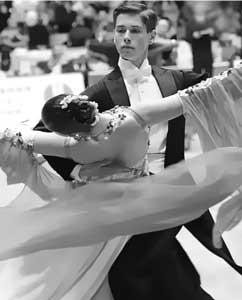
The Vienna waltz is structurally simple. But its constantly alternating, prompt right and left rotations demand from couple of coordination and grace. The competitive Vienna waltz (on the VI-th position) demands considerable progress, has the features in technology of execution of steps and the movement of the case.
The known option of execution of the Vienna waltz on the III-rd position keeps traditions of ballroom dances of the XIX century and enters a component a figured waltz, a waltz mazourka, a waltz gavotte and other dances.
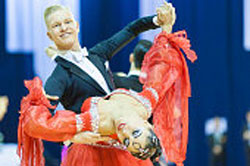
Currently, waltz is back in fashion: his dancing at the gala and dance evenings. In all the European capitals established tradition: first ball is white dress, tuxedo, waltz.
Size: 3/4.
Temp: 60 cycles or 180 beats per minute; three strokes per measure with an accent on the first beat. Basic rhythm: step on each quarter. Position: same position as the quickstep, the slow Foxtrot and the English waltz.
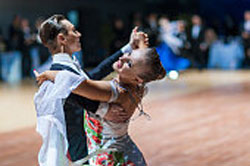
Note: If you have dizzy due to continuous rotation to right or left, take a few steps with pauses: "time" — step right foot forward; on "two" — to bring the left foot to the right; on "three" — slightly propel it forward. On the next beat, step left foot forward, shifting her body weight and so on, repeating the movement of the first measure, but with the other foot.
Right turn
The movement used is most often performed in 2 cycles.
For the Partner:
Begins and ends the movement of the face line of dance.
1. Step right foot forward turning right.
2. Big step left foot to side, continuing the rotation.
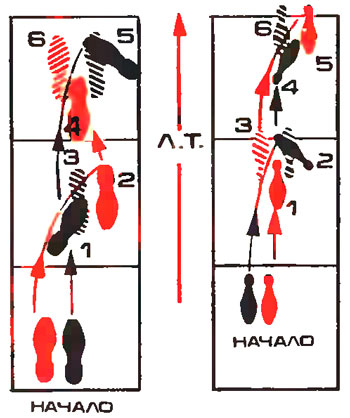
Fig. The right turn in the Viennese waltz. PA partner and partner
3. Fasten right leg to the left back along line of dance.
4. Step the left leg back, turning to the right.
5. A small step right foot to side right of left foot.
6. To fasten the left leg to the right leg.
Start again with # 1.
For the Lady:
Takes the opposite steps. The movement begins with the left foot and dancing to claim 4, 5, 6 and then 1, 2, 3.
Experienced dancers at 5, 6 perform the pivot on the left foot and the right foot puts to left with no weight transfer. MPC 1, 4. The rise at the end of 1. Top for 2, 3. Reduction at the end of 3. The rise at the end 4 top 5, 6. Reduction at the end of 6. Lean right 2, 3, left — 5, 6.

1. Left turn
This figure is combined with a right turn. Left turn — a great tool for those who are experiencing dizziness during the execution of the right turns of the waltz, as it gives the opportunity to interrupt the rotation, making a change forward and go to the opposite corners.
Motion begin and end at the line of dance.
For the Partner:
1. Step left foot forward turning left (account "raz").
2. A small step right foot to side right and slightly back, continuing the turn (the two).
3. Cross left leg in front right leg (cross), back along the line of dance ("three").
4. Step the right leg back with left (account "raz").
5. 6. To fasten the left leg to the right, not shifting her body weight, and execute the turn on the ball of the right foot (a sockwork pivot), taking the position face line of dance ("two", "three").
For the Lady:
Takes the opposite steps. Starts motion with the right foot and takes the first paragraphs 4, 5, 6, and then clauses 1, 2, 3.
MPC 1, 4. The rise at the end of 1, top 2, 3. Reduction at the end of 3. The rise at the end 4 top 5, 6. Reduction at the end of 6. Tilt left partner, right for their partner to 2, 3, 5, 6 — on the contrary.
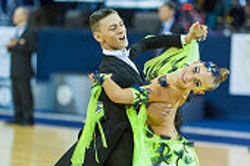
2. Lace
This figure is calculated on 12 beats (4 bars). It consists of:
1) the half-twist right— 1 tick;
2) two cross steps, 2 cycles;
3) the half-twist right — 1 tick.
For the Partner:
Begins and ends the movement of the face line of dance.
1. Step right foot forward turning body right (account "raz").
2. Step left foot to side left back along line of dance ("two").
3. Fasten right leg to the left back along line of dance ("three").
These three movements make up the first half right turn.
4. Step left foot back to line of dance (account "raz").
5. Cross right foot in front of left foot cross ("two").
6. Step left foot back to line of dance ("three").
7. Step right foot back along the line of dance (account "raz").
8. Cross left foot in front of right foot — cross (two).
9. Step right foot back along the line of dance ("three").
10. Step the left leg back with the body turning to the right (account "raz").
11. Step right foot to the right person on the line dance ("two").
12. To fasten the left leg to the right ("three").
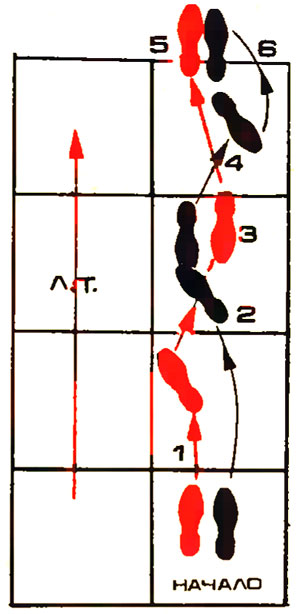
Fig. A left turn in the Viennese waltz
Motion p. 10-12 — the second half right turn.
For the Lady:
Performs the opposite steps, but instead of a cross step back takes two movements of the lock-step forward, one right, one left. In this figure, the partner moves forward along the line dance and partner ago.
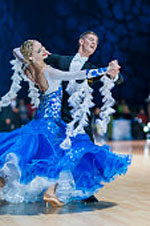
Chords and variations
1. Consisting of 4 cycles:
Right turn — forward change from the right foot, then left foot. Repeat.
Left turn — forward change with the left foot, then right foot. Repeat.
2. Consisting of 6 cycles:
Right turn — forward change from the right foot — left turn — forward change with the left foot. Repeat.
3. Consisting of 10 cycles:
The two right turn — forward change from the right foot — two left turn — forward change with the left foot. Repeat.
4. Consisting of 12 bars:
Turn right — lace — two right turn — forward change from the right foot, then left foot. Repeat.
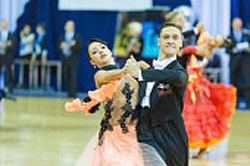
<< Back: West European ballroom dances
Maria Vasilevskaya "Dances from And to I" the Book about dances for laymen
We recommend that you look at the popular sections of the site myvaleology.com: MENU with a description of the sections | |||
| SOCIAL | DONATION | MY DIET | MY SPORT |

|
Release all4e8 |
||
Copyright © VZOJ 2023. All rights reserved. When reprinting or quoting myvaleology.com materials please put a link to the site myvaleology.com :
<a href="https://myvaleology.com">Healthy lifestyle</a>